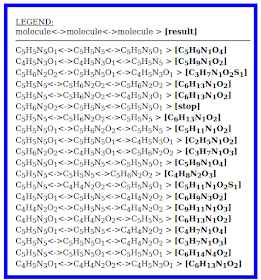 |
| Fig. 1 Synthesis of Appendix 1 and Appendix 2 |
I. Background
The previous post in this series featured appendices containing HTML tables depicting Toxoplasma Gondii ("Toxo") genomes (APNDX Amino Acids, Codons, Atoms, APNDX Sorted Amino Acids, Codons, Atoms).
The discussion in another post was that ("30-50% of humans are infected") Toxo infections are ubiquitous.
In today's post let's focus on the "embarrasment" of the microbiologists who consider "small things" but not the brains of those small things, if there is such a thing in Toxo.
One prime candidate for being considered as a brain in the small things considered department is the ubiquitous ribosome (as was considered in the previous post):
It would seem that the small brain considered (the ribosome) is quite artificially intelligent, even though it too (like the amino acids and codons) is just a group of atoms:
"Using a computer to simulate the interaction of 2.6 million atoms, Los Alamos National Laboratory researchers have re-created a tiny slice of one of the most fundamental genetic processes of life.
The lab simulated how a cellular machine called a ribosome follows genetic instructions to construct a complex molecule called a protein out of building blocks called amino acids. With 768 processors of LANL's 8,192-processor ASCI Q [human made] machine running for about 260 days, the researchers created a movie of the process. Previous views had shown only static snapshots."
(Lab computer simulates ribosome in motion, emphasis added). It took a human made super computer 260 days to depict what a microscopic machine does more quickly:
"the ribosome behavior that they simulated takes only 2 nanoseconds, or 2 billionths of a second"
(ibid). That somehow explains the time doll ("When the universe [doll] was very young — something like a hundredth of a billionth of a trillionth of a trillionth of a second (whew!) [the time doll was ... conjured ... shortly after that] — it underwent an incredible growth spurt", Quantum Biology - 9).
Go figure.
(Small Brains Considered - 9, at section "IV. Analysis"). Keeping that in mind, the big story to add to that is Fig. 1 which depicts concisely what the ribosome does when processing a Toxo genome gene segment.
 |
| Fig. 2 Atomic Photo Album |
The appendices linked to in Fig. 1 are Toxo genome entities that process mRNA when the nucleus of the Toxo eukaryote cell's machinery (I guess the small things considered intellectual machinery would call it "the nuclear brain") translates/transcribes the Toxo DNA into Toxo mRNA, then "ships it" (Federal express, UPS, Amazon) out of the nucleus out to the badlands where the ribosome machines are located.
NOTE: The ribosome is depicted by scientists as a molecular machine because it is not a biotic entity, it is an abiotic entity (not alive, see The Abiology Rebellion).
This is in accord with the new scientific paradigm (The New Paradigm: The Physical Universe Is Mostly Machine, 2, 3).
II. Down To The Brass Tacks
The first line of the Fig1 graphic is:
C5H5N5O1<->C5H5N5<->C5H5N5O1 > [C5H9N1O4]
That indicates that the ribosome uses the three molecules of atoms, picking and choosing this and that atom from those three molecules to produce the C5H9N1O4
amino acid group of atoms (it's like a line-up down at the station Fig. 2).
Using simple arithmetic we can deduce that one third of the carbon (C) atoms in the three codon molecules were used (two thirds were put in the waste basket I suppose), nine of the fifteen hydrogen (H) atoms were used and six were tossed, one of the fifteen nitrogen (N) atoms were used, fourteen were tossed, and somehow four oxygen (O) atoms appeared when only two were in the codon.
You can go down the list and notice that the arithmetic is strange (especially so since the magnitude is overwhelming in the sense that there are ten million ribosomes in each eukaryotic cell: Encyclopedia Britannica).
And that is the simple part, in the sense that this atomic surgery happens in the proverbial blink of an eye ("the ribosome behavior that they simulated takes only 2 nanoseconds, or 2 billionths of a second").
How the "the nuclear brain" (nucleus) changes the
| Thymine | T | THY | C5H6N2O2 |
into:
| Uracil | U | URA | C4H4N2O2 |
is another arithmetic "subtraction miracle" or perhaps they aren't over their "T" is "U" and "U" is "T" thingy yet I suppose (It's In The GenBank - 4).
III. Closing Comments
See the last video below for an excellent overview of the eukaryotic cell nucleus's transcription/translation dynamics.
See the Falkowski video just below for an honest scientist's appraisal about the most-honest we can be with our words ("we don't know"):
 |
| Dr. Paul Falkowski |
(From the video transcript, emphasis added).
The next post in this series is here, the previous post in this series is here.
No comments:
Post a Comment